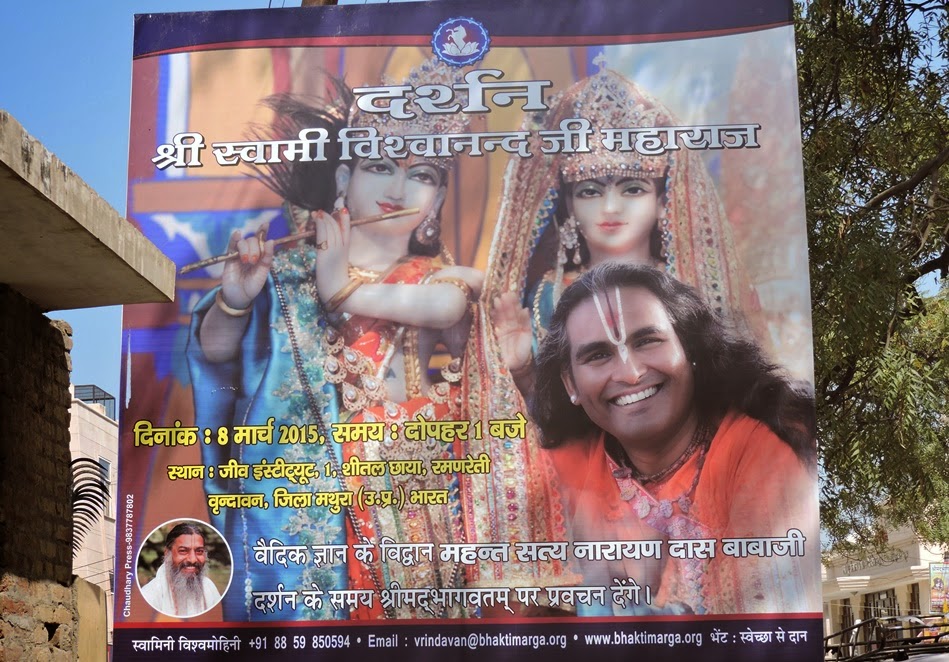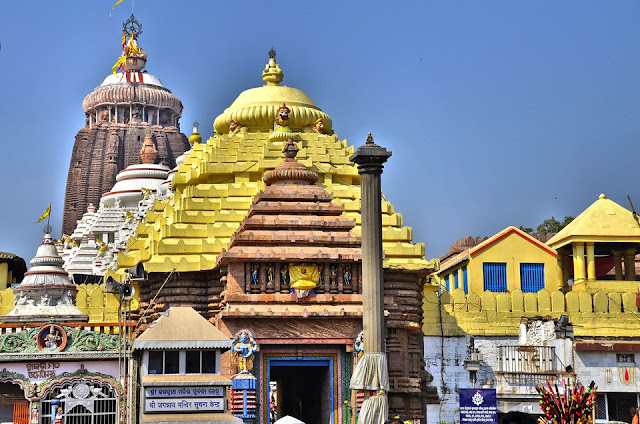Traditional Sanskrit knowledge and me
I just came back from a Smriti Sabha on the Parikrama Marg for Shyama Sharan Nyayacharya, who was Satya Narayan Dasji's pandit for more than 20 years. Babaji regularly studied from him--Yoga Sutra, nyaya, Vallabhacharya, Nimbarkacharya, Mimamsa, and more. The list is quite long. Shyama Sharan left his body in Vrindavan a little over a week ago, and this was the official memorial.
 |
Ramanandacharya Shri Ram Nareshacharya Ji Maharaj |
At first Satya Narayan Dasji used to go to read with him at Ananda Vrindavan, Akhandananda Saraswati's ashram in Moti Jheel, but after Akhandananda's disappearance, it became somewhat uncomfortable for him there, so he asked Satya Narayan to build him a kutir near the Krishna Balaram tree, just at the corner of Sunrakh Road, which is right in the Angrez part of town. Nevertheless, for all those years, despite his great enthusiasm to teach, he had few students. Certainly none with the lifelong commitment to learning that Satya Narayan showed.
Two thoughts came to mind. The first is related to the ecumenism of the group. Shyama Sharan was a Nimbarki, but he had studied with the Ramanandacharya in Rishikesh and Benares. His main student was a Gaudiya, and his first love, apparently, was Vallabhacharya's commentary on the Bhagavatam. It was clear that although there are many branches of Vaishnavism, the spirit of collegiality was there, despite inevitable disagreements on siddhanta. At least to honor this sadhu, there were representatives from all around, in the love of traditional Sanskrit knowledge and its branches. This struck me because I have just been in contact with some anti-Hindu fundamentalism types, and this assembly seemed to epitomize, at least in a restricted way, a kind of relaxed unity that Hindu liberalism can enjoy.
The second is more personal. In his speech Satya Narayan Dasji spoke of the waning of traditional Hindu scholarship. Shyama Sharan had few students. Indeed, I believe that Satya Narayan was the only one there who made the claim, and he was treated with a great deal of respect by the assembly. He made the point that there are so many programs to save endangered species like tigers, but no such effort is being made to preserve the traditional kinds of knowledge in the traditional manner. As a result, scriptural knowledge is becoming endangered in India, with popular religion ignoring the subtleties of the time honored Sanskrit traditions. The effect carries over: saving the Yamuna, for instance, is futile if the culture of honoring the sacred river is lost, and such culture depends greatly on the solid respect for traditional scholarship.
Satya Narayanji quoted Shyama Sharan as saying that "the Bhāgavata has ruined Vrindavan"! I have heard Haridas Shastri state a similar opinion. It also reminds me of Ananta Vasudeva, whose disciples told me that he blamed Gauḍīya-kaṇṭha-hāra for allowing the Gaudiya Math to depend on facile dogmatism based on selected verses rather than understanding the subtleties of Jiva Goswami's thought. He even stopped all math activities so that everyone could study the Sandarbhas in depth, especially Bhakti-sandarbha.
It seemed a bit strange for Satya Narayan Dasji to say that, as he is about as committed to the Bhāgavata as you could be... but of course, he sees the Bhāgavata not as stories, but as philosophy, through the optic of its numerous commentators, especially Jiva Goswami, to understand whom he has gone deeply into the other branches of Sanskrit knowledge that Sri Jiva would have been versed in. Indeed, any great acharya, whether Sri Jiva or the other Goswamis, or Vallabha and his descendants, would have mastered grammar and the six darshans as a matter of course. Such polyvalent mastery is becoming a rarer and rarer thing, and now just enough knowledge is needed to entertain the masses.
Indeed, as I stated above, I enjoyed myself. I confess, I like these assemblies of learned Sanskrit scholars. I like the quoting of Sanskrit shlokas, the easy references to obscure points of nyaya or Madhusudana Saraswati's commentaries, and the way that they are weaved into anecdotes. But I like the popular Bhāgavata discourses as well.
When I am in such an assembly here in Vrindavan, it is easy for me to slip into this reality, the reality of this world of sadhus and sampradayas and Sanskrit scholarship. This is my home. It is a totally different one from that which I came in so many ways. But the fact is that it is not quite the world that I am preaching, and in many ways quite different. I am resigned to the inevitability of change, and at the same time I am a believer that traditional scholarship is unlikely to go completely extinct, though it will always be a rarified breed that chooses these stomping grounds.
I am living here in Vrindavan -- two years ago I would have written an account, a report, for Vrindavan Today. But VT is only a passing thought today. I am pearticipating less and less in the local community, though I cycle daily to Jiva Institute and work with Babaji on the Sandarbhas. In fact, you might say that this is the first time in my life that I have really followed the traditional system, one on one with a pandit to study a text line by line from beginning to end.
I was editing the English translation, but at one point I realized that I would need to understand the subtleties of the argumentation in Sanskrit a little better and so I asked Babaji if we could go through the text and translation together. So I spend the day working on the text and in the afternoon we read both Sanskrit and English for an hour or two. And it is quite rewarding an experience.
So, though I am getting a taste for this world, at night I go looking through my old articles, finished and unfinished, and contemplate what to do with them all. How to make something coherent and cogent out of this tangled mess? And this is not the "traditional knowledge." I am still, for all of it, a Westerner observing a world that I love more than anything the Western world has to offer me. I am a part of this world, but still apart.
The 1997 articles I am currently revising and posting on the blog were written only a couple of years after I got my doctorate from SOAS. It was the beginning of the end of my academic career, in the sense that I never held a full time academic job after that, so I was little or no contact with academia at the time. I made renewed contact with devotees on the Internet, which was still a novelty in those days, after a hiatus of pretty much a decade.
The first devotees who heard me talking reacted predictably, from disappointed to downright nasty. Kundali Das was also on that group and he made a complete ass of himself, talking condescendingly to devotees and insulting them. It might not have been entirely unwarranted, but I have observed that this is a trap that those who discover "Western knowledge" find themselves in. I tried as best I could to avoid it myself, primarily because my experience of the Vaishnava world stretches far beyond ISKCON and Srila Prabhupada. But those were the early days of internet listserves and the such, and flame wars were inevitable.
Perhaps my time as a babaji and outside of ISKCON in Nabadwip and Braj inoculated me against this kind of militant spirit. And I think it also protected me from becoming overly influenced by the Western scholarly ideas, even though I was clearly making challenges that most ISKCON devotees do not take into consideration.
Looking back at these articles, I see how I took such a strongly Westernized position -- demythologizing, attempting to formulate a rational point of view where guru-tattva and Prabhupada were concerned, feminism, and various other things that are likely never going to fly on the basis of Sanskrit scholarship... at least not alone. And though I am not as forceful in my presentation nowadays as I was in 1997, when really it all came bursting out and I was telling devotees for the first time what I really thought on the basis of my attempts to understand Krishna consciousness as an objective phenomenon.
My conclusion had been that we need to separate the essential from the peripheral where our beliefs were concerned or Krishna consciousness just wasn't going to fly in the West. As a matter of fact, it was not going to fly for me, either. I figured I had understood enough of what Rupa Goswami is all about (I didn't), both intellectually and practically, but I had a big problem. I was no longer a member of the orthodox Vaishnava school, at least not in terms of belief, and I needed to deal with that intellectually. So above all I needed to understand the phenomenon of religion itself scientifically, as objectively as possible, in the Western manner. To see if I could make Rupa Goswami's ideas about madhura-rasa a real, living thing, in this world. In other words, to prove "pragmatically" that prema is the prayojana.
In other words, to have a thorough grasp of both Indian and Western approaches in order to synthesize them. It is the only way to do honor to our history, set into motion by the transplantation of Vaishnava ideas in the West.
I left India in 1985 and returned to university in order to get a broad scientific perspective on religion and to use it to analyze my personal experience of fifteen years in Krishna consciousness, both in the West and in India. And the things that I learned seemed pretty dang useful.
"
There is a lot in traditional Hindu knowledge, even though it is almost by definition very conservative. But I am never going to be a Ram Naresh Ramanandacharya. Nor for that matter a Satya Narayan. Actually, in going after both I may well be without either, like Arjuna's chinnābhram iva nashyati. Without honor or standing in any sphere.
Nevertheless, I am ultimately not here for any kind of scholarship, eastern or western. I am here for prema. And prema, of all things, is something for which you really have to depend entirely on Radharani's mercy, following the breezes of her grace as you cross the ocean of samsara.
I don't know about India so much, but I think that some people, especially Western ones whose brains give them problems, will appreciate any help I can give them in getting past their brains to prema.
Jai Sri Radhe.



Comments